Demarest Rebecca - Making makers: kids, tools, and the future of innovation
Here you can read online Demarest Rebecca - Making makers: kids, tools, and the future of innovation full text of the book (entire story) in english for free. Download pdf and epub, get meaning, cover and reviews about this ebook. City: Sebastopol;California, year: 2014, publisher: Maker Media, Inc., genre: Home and family. Description of the work, (preface) as well as reviews are available. Best literature library LitArk.com created for fans of good reading and offers a wide selection of genres:
Romance novel
Science fiction
Adventure
Detective
Science
History
Home and family
Prose
Art
Politics
Computer
Non-fiction
Religion
Business
Children
Humor
Choose a favorite category and find really read worthwhile books. Enjoy immersion in the world of imagination, feel the emotions of the characters or learn something new for yourself, make an fascinating discovery.
- Book:Making makers: kids, tools, and the future of innovation
- Author:
- Publisher:Maker Media, Inc.
- Genre:
- Year:2014
- City:Sebastopol;California
- Rating:4 / 5
- Favourites:Add to favourites
- Your mark:
- 80
- 1
- 2
- 3
- 4
- 5
Making makers: kids, tools, and the future of innovation: summary, description and annotation
We offer to read an annotation, description, summary or preface (depends on what the author of the book "Making makers: kids, tools, and the future of innovation" wrote himself). If you haven't found the necessary information about the book — write in the comments, we will try to find it.
Making makers: kids, tools, and the future of innovation — read online for free the complete book (whole text) full work
Below is the text of the book, divided by pages. System saving the place of the last page read, allows you to conveniently read the book "Making makers: kids, tools, and the future of innovation" online for free, without having to search again every time where you left off. Put a bookmark, and you can go to the page where you finished reading at any time.
Font size:
Interval:
Bookmark:
For Sage and Grace
The goal of Maker Faire is to make more makers, so since 2006, we have gathered makers together and celebrated what they do. In 2013, there were 100 Maker Faires around the world, and a growing number of attendees are families. From the very first, we understood that meeting makers and seeing their projects inspired others to see themselves as makers. We invited everyone to get involved by creating and sharing projects based on their own interests and skills. While I knew Maker Faire would appeal to adults, I was surprised to see how kids were fascinated by the amazing variety of projects; they wanted to participate, and they wanted to become makers themselves. Sometimes, their own interest surprised their parents too!
At Maker Faires, parents were noticing how their children liked to play with cardboard as well as wood, how they liked to learn to use tools and how they liked to tinker. I suspect that some of these practices had fallen by the waysidewhat seemed obvious and good to do for generations had been lost, forgotten, or just taken for granted. There is little hands-on learning found in classrooms. On playgrounds or outside of school, there is very little time for unstructured play. It wasnt clear how a child could become a maker without adult involvement. Fortunately, parents have began to discover that making is something to do together for fun while also being an authentic form of learning.
At Maker Faire Bay Area in 2014, I had a conversation about making and parenting that has stuck with me. Mike Neden, a professor of technology and engineering education at Pittsburg State in Kansas, was hanging out in the booth for Rokenbok, a 3D construction kit for kids. As parents and their children interacted with the kit and began building things, Mike found that parents asked questions about how kids learn, and more specifically, how they might learn to become engineers and scientists. Many of the parents asking questions had these careers and were working in Silicon Valley. Mikes comment to me was that these parents werent sure how they themselves became engineers and scientists and were wondering how their own children might become them too. They understood the value of what they had learned to doand how they thoughtand they wanted to pass that on to their children. Ive also met and talked to parents, particularly those like Julie Hudy, who we call Maker Moms. They recognize in their children the interest in and capability for making things. Because these parents are not makers themselves, they want to know how to support their children, whose experiences and interests are so unlike their own.
I am proud to publish this book by AnnMarie Thomas. It is a guide for parents who want to engage their kids as makers, but it is not a how-to guide or a self-help book. It offers insight into what we call a maker mindset, which is a way of engaging with the world and gaining access to a toolset that is both mental and physical. The maker mindset can be used to change the world for the better. Dr. Thomas, a maker, a teacher, and a mother, helps us learn from makers so that all of us can foster the qualities we value most in them. It is clear that what many appreciate about making is not just the finished product, but also the character traits that the process helps develop.
Making is more than hands-on projects, but it starts with them. You can find lots of guides that tell you or your child how to learn electronics, woodworking, welding or sewing. You can find a variety of ways to engage children in building practical skills and developing original ideas. Yet what happens with a childs hands and what he or she creates are not nearly as important as what happens inside the child. This is what Piaget, a pioneer in our understanding of child development, called cultivating the experimental mind in his book To Understand is to Invent . He talked about a kind of active education that would lead the child to construct for himself the tools that will transform him from the insidethat is, in a real sense, and not just on the surface. We can give our children access to tools and the time to practice using them to develop creative and technical projects. Yet, as parents who are makers, our most important project is helping our children become creative, lifelong learners. We need adults to facilitate these experiences and to create makerspaces in their communities that are accessible to all children.
Making more makers is what each of us can do, and what we must do together. These are the children who will make the future.
How are you going to design something if youve never built anything?[]
William Guilford (University of Virginia Engineering professor)
In the fall of 2011, as I was taking a break from grading my students assignments, I found myself stopped by the preceding quote in an engineering education magazine. After six years of teaching undergraduate engineering design classes, I shared Dr. Guilfords sentiment. In my classes, I found that the truly innovative designs most often came from students who were able to couple rigorous analysis (which is the focus of many engineering programs) with a practical knowledge of how machines work. The latter is knowledge that comes primarily from taking things apart, putting them together, and learning what has worked (or not worked) in other devices. While I can assume that all of the first-year engineering majors that I teach have taken a math class, I cant assume that theyve spent time taking things apart or building things. As someone who reveled in making things (out of wood, out of cardboard, out of fabric, out of sand, out of anything) as a child and teenager, I had a hard time wrapping my head around the idea that many young adults, particularly those who were going into a field of study focused on creating things, had so little experience actually making things.
I read Guilfords article the same week that I attended World Maker Faire in Queens, NY. This event celebrated the creators of things ranging from robots to costumes. The engineering professor in me saw some incredible examples of technology, but more than anything, what I noticed were the people who were passionate about creating things and sharing their knowledge with others. The excitement was infectious and evident in attendees of all ages. Throughout the fairgrounds, there were opportunities for children and adults to learn skills like soldering, energizing conversations about the intricate details of various 3D printers, makers young and old showing off the things theyd made, and a pervasive air of curiosity. That sense of curiosity and collaboration is what I wish for all of my students, as well as for my own children.
I am definitely not alone in my desire to encourage children to actively create the world around them. Makerspaces, places where people get together to use tools and work on projects, are popping up around the world. Were seeing them in libraries, schools, community centers, and homes. Project instruction sharing sites (like Instructables and Make: Projects) allow users to freely share step-by-step directions for making everything from playful electronic gadgets to furniture to tomato soup. The Maker Movement, and the self-identified makers who are at the heart of it, are celebrating many of the qualities and actions that educators have long been trying to promote: lifelong learning, self-directed learning, communication, collaboration, creativity, and design. At a time when there is an increased emphasis on STEM (science, technology, engineering, and mathematics) in the PK12 curriculum, the growth of the Maker Movement presents great opportunities for increasing technical literacy and reintroducing people of all ages to the arts of making and tinkering. The kids I watched at World Maker Faire, and at every Maker Faire Ive attended, are asking great questions and doing real projects with the purest of motivations: they are curious and having fun. They arent attending because its a homework assignment, or learning to solder because it might be on a test. To be honest, most of them probably arent even sure why learning to solder is useful yet; they just know that if they learn to do it in the Learn to Solder tent theyll get to wear, and keep, a cool blinking-light badge. But theyll leave the faire with more than just that badge. Theyll leave knowing
Font size:
Interval:
Bookmark:
Similar books «Making makers: kids, tools, and the future of innovation»
Look at similar books to Making makers: kids, tools, and the future of innovation. We have selected literature similar in name and meaning in the hope of providing readers with more options to find new, interesting, not yet read works.
Discussion, reviews of the book Making makers: kids, tools, and the future of innovation and just readers' own opinions. Leave your comments, write what you think about the work, its meaning or the main characters. Specify what exactly you liked and what you didn't like, and why you think so.

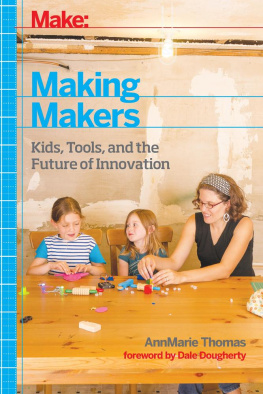
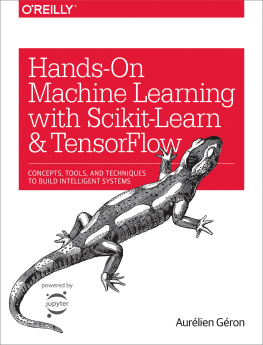

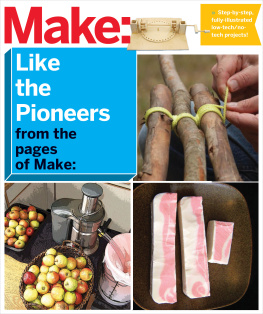
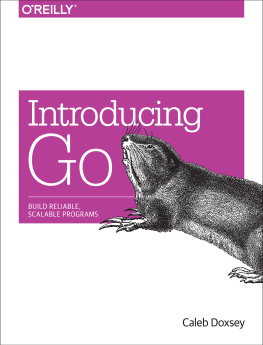
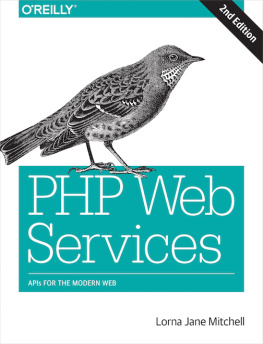
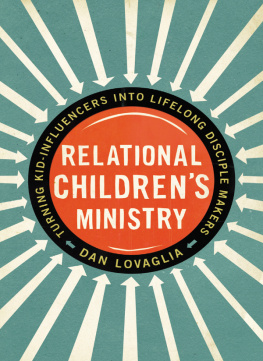


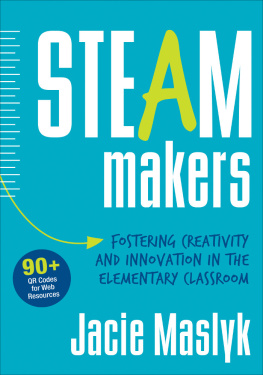




![Aliverti Paolo - The Makers manual: [a practical guide to the new industrial revolution]](/uploads/posts/book/177221/thumbs/aliverti-paolo-the-maker-s-manual-a-practical.jpg)